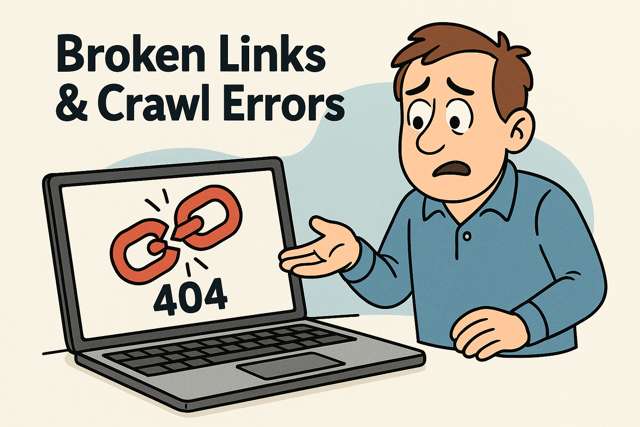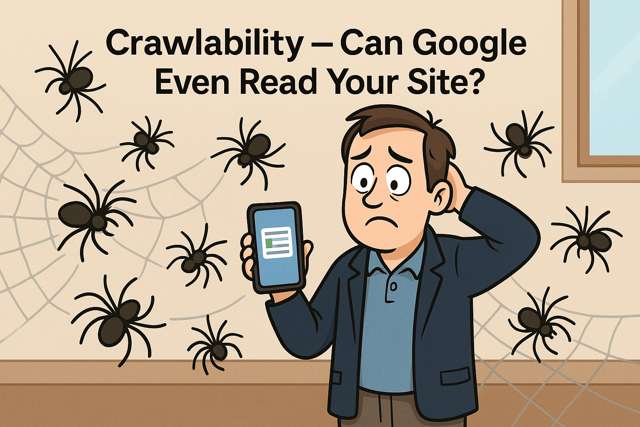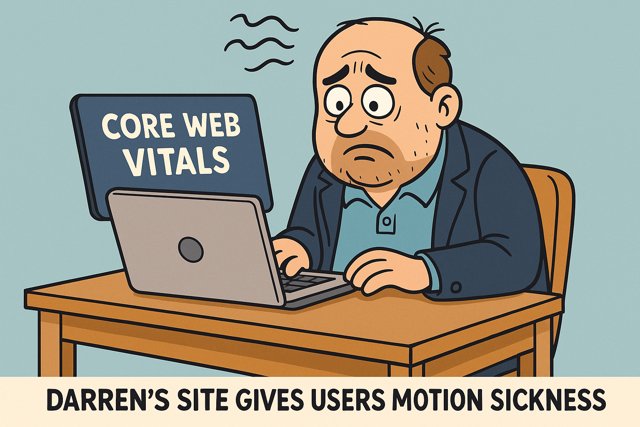
Introduction: Darren and the Digital Black Hole
So Darren’s gone straight — sort of. He’s dumped the mistresses (well, most), binned the Crocs, and now runs a fishing tackle website from his shed. He’s even stopped selling dinghies to smugglers — progress! But lately, his traffic’s tanked harder than his political career. Why? Technical SEO issues.
Because Darren ignored technical SEO. His site’s like a haunted theme park: slow, broken, and full of hidden horrors. And when Google’s bots crawl it, they don’t say “ooh, nice carp rods,” they scream and run. So if your pages aren’t showing up, loading like molasses, or randomly vanishing into the 404 void — it’s probably not your content. It’s your technical bullshit.
Let’s fix that.
1. Page Speed — Darren’s Site Moves Like a Pissed Slug
Your site needs to load fast. Not “eventually.” Not “if the Wi-Fi’s good.” FAST. Google cares, your customers care, and Darren definitely should’ve cared before uploading a 20MB JPEG of himself holding a carp, topless, in soft focus.
Why It Matters:
- Google ranks slow sites lower — fact.
- Visitors bounce if your site takes more than 3 seconds.
- Mobile users are ruthless. If it drags, they’re gone.
Darren’s Case:
Darren’s homepage took 11.4 seconds to load. Why? Because he:
- Uploaded uncompressed images the size of satellite photos.
- Used a theme from 2012 coded like spaghetti.
- Had five tracking scripts from random marketing “gurus” (one possibly spyware).
How to Fix It:
- Compress your images with tools like TinyPNG or Squoosh.
- Use modern file types like WebP.
- Get rid of ancient WordPress plugins Darren probably found in a forum from 2006.
- Test your speed at PageSpeed Insights — if your score’s red, it’s time for tech CPR.
Final Tip:
You’re not making a Netflix documentary. No one needs high-res trout in 4K. Make it snappy. Like Darren’s denials at a press conference.
2. Mobile Friendliness — Darren’s Site Is a Finger Gymnastics Nightmare
These days, most people visit websites on their phone. But Darren? He built his site on a desktop from 2009 and never once checked what it looked like on mobile. The result? A homepage that requires zooming, pinching, squinting, and occasionally prayer.
Why It Matters:
- Google only uses the mobile version of your site for ranking (this is called mobile-first indexing).
- If your mobile layout sucks, your SEO suffers — even if your desktop version is spotless.
- Users won’t wrestle with broken layouts. They’ll just leave.
Darren’s Case:
His product images overlapped with text.
His buttons were too tiny to tap unless you had hummingbird fingers.
And worst of all — his cookie banner covered the whole screen on mobile and couldn’t be closed.
How to Fix It:
- Use responsive design — your site should adapt to all screen sizes. Most modern themes do this by default.
- Check your site on your phone. If you’re frustrated, your customers will be too.
- Use Google’s Mobile-Friendly Test — and don’t ignore the results like Darren ignored Parliament ethics.
Final Tip:
If someone can’t buy your product without rotating their phone like a steering wheel, you’re not mobile-friendly — you’re mobile-hostile.
3. Broken Links & Crawl Errors — Darren’s Site Is a Dead-End Maze

Google sends bots (remember those gremlins?) to crawl your site. But when they hit broken links or missing pages (404 errors), it’s like sending them down a hallway that ends in a brick wall. They get confused, frustrated, and sometimes just leave — a bit like Darren’s customers.
Darren’s Dilemma:
He linked half his blog posts to pages that no longer exist, like his 2014 carp diary or a reel review that mysteriously vanished (possibly after legal threats). Google kept trying to visit those pages, but they were dead ends. Result? SEO penalties and visitors who hit a 404 and bailed.
Why It Matters:
- Broken links damage trust and user experience
- Google reduces the crawl rate on unreliable sites
- You lose out on SEO juice that could be flowing through good internal links
How to Fix It:
- Use tools like Google Search Console, Screaming Frog, or Ahrefs Site Audit to spot broken links and crawl errors
- Fix the URL if the page still exists
- Redirect old links to new pages using 301 redirects
- Delete links pointing to nowhere
Darren’s Redemption:
He fixed 27 broken links, added proper redirects, and his bounce rate dropped from 82% to 47%. His customers no longer felt like they were falling into digital sinkholes. Some even bought bait.
4. Crawlability — Can Google Even Read Your Site?
Darren spent three weeks building his homepage, only to realise Google couldn’t even see it. Like putting up a billboard in the woods and wondering why nobody calls.

Why It Matters:
- If Google can’t crawl your site, it can’t index it
- No index = no ranking = digital invisibility
- Most crawl issues are dumb mistakes — but they matter
Darren’s Disasters:
- Accidentally blocked Google in
robots.txt - Had a noindex tag on half his pages
- Installed a “coming soon” plugin and forgot to take it off
- Linked between pages using dodgy JavaScript, so bots couldn’t follow
How to Fix It:
- Check your
robots.txtfile (shouldn’t block key pages) - Remove “noindex” tags unless you’re hiding content deliberately
- Use clean, crawlable links (no weird JavaScript or AJAX for navigation)
- Submit a sitemap in Google Search Console and monitor coverage errors
5. HTTPS Security — Darren’s Site Says “This Might Be a Trap”
If your site still uses HTTP instead of HTTPS, modern browsers slap a warning on it that basically says, “This site might steal your kidneys.” Not great for trust.
Why It Matters:
- HTTPS is a Google ranking factor
- Browsers show “Not Secure” warnings without it
- It encrypts data — crucial if you take payments or collect emails
Darren’s Blunder:
He thought SSL was “some crypto coin” and ignored it. His site flagged red, scaring off anyone who wasn’t already dodgy.
Fix It:
- Get a free SSL certificate from Let’s Encrypt (most hosts offer this)
- Force all pages to load via HTTPS
- Update old HTTP links in content and sitemaps
6. Duplicate Content — Darren’s Copy-Paste Chaos
Darren reused entire blocks of content across multiple pages. Why write fresh when you can Ctrl+C, Ctrl+V, right? Except Google hates duplicate content.
Why It Matters:
- Confuses search engines
- Dilutes SEO value
- Can get you penalised for low-quality content
Fix It:
- Use canonical tags to tell Google which version is “the original”
- Rewrite reused content so each page offers unique value
- Don’t copy product descriptions from manufacturers — Google’s seen them 10,000 times
7. Sitemap & Indexing — Darren Forgot to Give Google a Map
Your sitemap is like the table of contents for your website. Without it, Google’s bots are just stumbling around hoping to find stuff.
Why It Matters:
- Helps Google discover and index your pages
- Makes sure new content gets picked up fast
- Highlights issues in Search Console
Darren’s Crime:
No sitemap. No indexing. His blog posts were floating in the SEO void. His homepage was the only thing ranking — badly.
Fix It:
- Create a sitemap.xml file (Yoast or RankMath can help)
- Submit it in Google Search Console
- Check for indexing errors or exclusions
8. Core Web Vitals — Darren’s Site Gives Users Motion Sickness
Core Web Vitals are Google’s way of measuring user experience. It looks at load time, interactivity, and layout stability (e.g. buttons jumping around).

Why It Matters:
- Directly affects rankings
- Impacts bounce rate and conversion
- Core part of Google’s Page Experience algorithm
Darren’s Symptoms:
- Images loaded late and pushed content around
- Buttons took 5 seconds to react
- Fonts flickered in and out like a ghost
Fix It:
- Load critical CSS early
- Use
font-display: swap - Defer non-critical JavaScript
- Compress and prioritise assets
9. Structured Data — Darren Thinks Schema Is a New Drug
Structured data (like schema.org) helps Google understand your content better — reviews, FAQs, prices, etc. It’s what powers rich snippets.

Why It Matters:
- Improves visibility in search (stars, images, FAQs)
- Helps with click-through rates
- Makes your site stand out
Darren’s Confusion:
He saw “schema markup” and thought it was some kind of herbal supplement. So he missed out on all the fancy extras in Google search.
Fix It:
- Use tools like Google’s Rich Results Test
- Add schema for key pages (products, blogs, FAQs, reviews)
- If using WordPress, install a plugin like Schema Pro or Yoast
10. FAQs About Technical SEO
Q: How do I know if my site has technical SEO problems?
A: Use tools like Google Search Console, PageSpeed Insights, or Screaming Frog. If red errors pop up like Darren’s tax returns, you’ve got work to do.
Q: Is page speed really that important?
A: Yes. Slow sites kill rankings and user patience. If your homepage loads slower than Darren answering tough questions, fix it fast.
Q: What is crawlability, and why should I care?
A: It’s how well Google can read your site. If bots can’t crawl it, you’re basically invisible — like Darren’s moral compass.
Q: Can broken links hurt my Google rankings?
A: Absolutely. Broken links = broken trust. Users hate them, and so does Google. Patch them up before your SEO leaks everywhere.
Q: Do I really need HTTPS?
A: Yes. Without it, browsers warn users that your site is “Not Secure.” Not ideal if you’re selling things (or dignity).
Q: How often should I check for SEO issues?
A: Every couple of months. It’s like a dentist visit — ignore it too long and things start to rot.
Q: Is technical SEO just for developers?
A: Nope. With plugins, tools, and guides like this, even Darren could do it. And he once tried to fix a server with duct tape.
Summary: Technical SEO — Don’t Be Darren

You could write the world’s greatest blog post about carp bait, but if your site’s slow, broken, invisible to Google, or flagged as a security risk — nobody will ever see it. Technical SEO isn’t optional. It’s the plumbing, wiring, and foundation of your digital shop.
Darren ignored it, and ended up with a haunted shed of a website. But you? You’ve got no excuse. Sort your site speed, fix your mobile layout, clean up crawl errors, and give Google a clear map. Do the geeky stuff now — or stay buried on page 12 with Darren’s dodgy affiliate links.
Leave a Reply